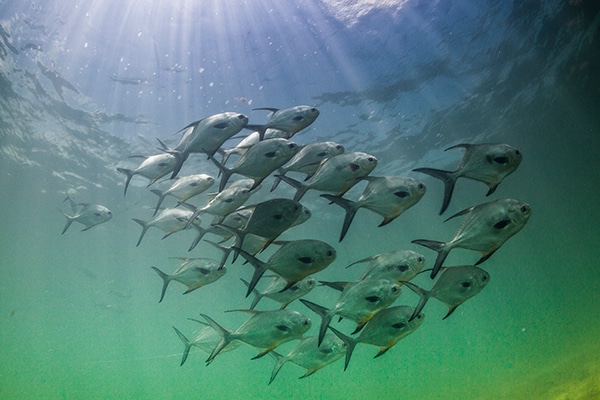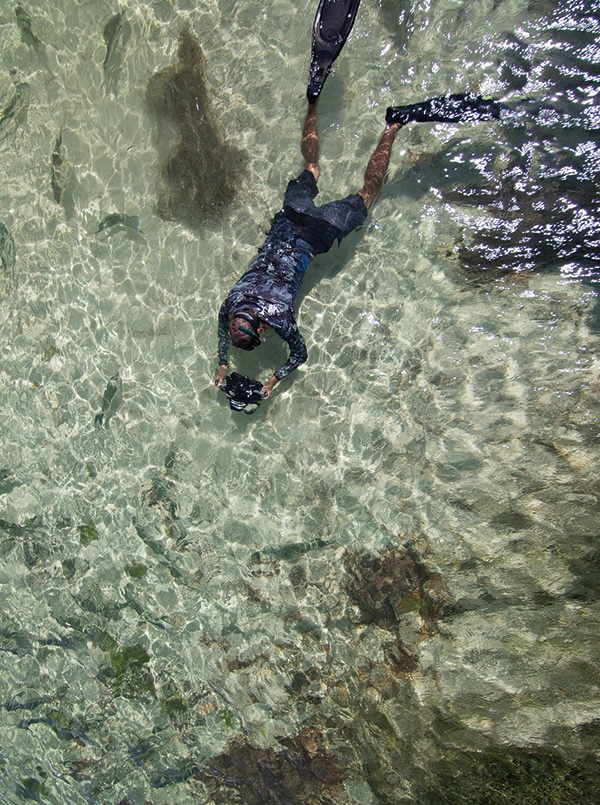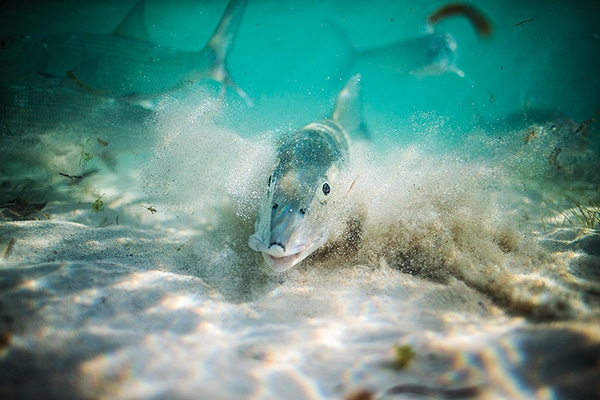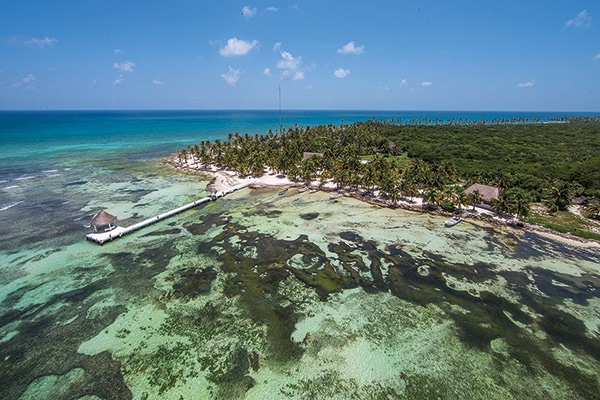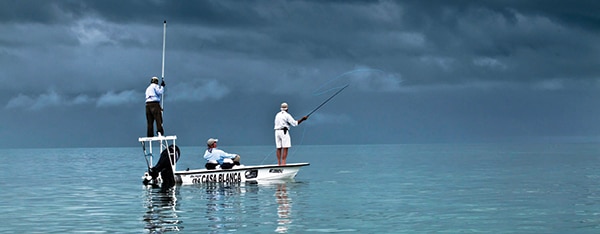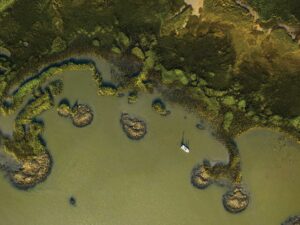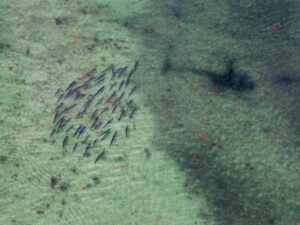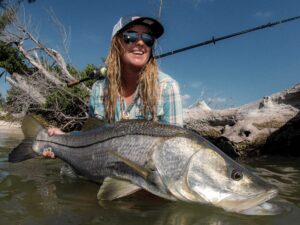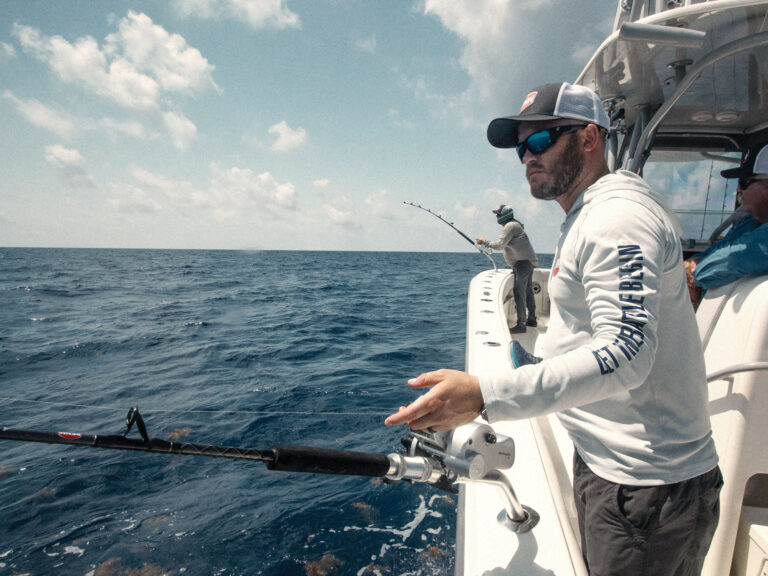Sian Ka’an, in the original Mayan Indian language, means birthplace or origin of the sky. Well known to fly-fishermen, the reserve is home to the famous Casa Blanca Lodge and some of the best permit fishing in the world. During a trip there in 2011, as a guest of my good friend and Glen Raven CEO Allen E. Gant Jr., I fell in love with the place. Allen is a passionate conservation-minded fly-fisherman who thoroughly enjoyed being a part of my efforts to photograph bonefish and free-swimming permit. Several weeks after returning to the States, I joined him for lunch. As we discussed the Yucatán, he suggested making a film about the Sian Ka’an and its giant bays of Espiritu Santos and Ascension. Through Glen Raven, which manufactures Sunbrella fabrics, he was looking for an opportunity to be part of a project that met his values regarding the environment. Allen asked if I would be interested in shooting the film.
I left lunch punching the air because I was so excited, but I soon settled into a state of panic when the immense size of what he wanted me to do struck home. I have spent the last 20-plus years of my life shooting marinecentric still images around the world; the last decade focused almost solely on shooting fish in their environments — completely wild and free. From blue and black marlin to both species of sailfish, bonefish, permit and tarpon, I have looked for those almost impossible shots. My still photographic work had started to morph into motion pictures during the previous years as I began shooting high frame rates on a 14-frames-per-second motor drive. Reviewing these images, I could see the huge changes every hundredth of a second, as a fish would come in to eat. This enthralled me. With the move to motion came this new, incredible opportunity to tell deep and complex stories over longer periods of time, not just the few moments one might look at a still image. But from producing a few behind-the-scenes videos about our photographic adventures, suddenly I was being presented with one of the most unbelievable dream projects I could have imagined. I just wasn’t sure I was ready to bite off something this big. But of course I said yes.
Thankfully, Casa Blanca Lodge obliged with great support and has been able to present me with necessities such as expert guides and on-the-ground logistics in this very remote area of Mexico. The fly-fishing aspect of this film will focus on the fact that the sport has a very low environmental impact but still creates sustainable jobs, which has everything to do with the success of the reserve’s future. That being said, at the top of the shot list are the three holy grails of the flats: bonefish, tarpon and, most of all, permit. Along with story lines about their life cycles and behaviors is the incredible relationship that exists between the beauty of these fish and the grace and elegance of fly-fishing. This correlation is what I aim to capture in this project.
The shots had to be different — which is the way I’ve always approached my visuals. Hours and even days of planning have gone into each shot. I wanted, for example, to shoot bonefish free-swimming inches from the lens. Most people, including my guides, called me loco. The shots started out with camouflaged radio-triggered cameras placed on the flats, followed by hours, and eventually days, of sitting 200 yards away in a skiff getting broiled by the sun, waiting for a school to swim up to the crab bait in front of the camera. After much trial and error, we refined the process and were able to spend much of our first trip of the project underwater, literally lens to nose with a school of bones, for several hours each day for a number of days.
That in itself was fantastic, but even better was that we were shooting the whole feeding process with a high-speed camera. This produced the most incredible slow-motion shots of bones working the sand, blowing in search of food, the soft skirts of their mouths opening and closing like bellows. In slow motion you can see the delicate ballet of their caudal and pectoral fins allowing them to hover in position as they suck sand from around a possible prey and discharge it in clouds from their gills. After shooting the same school of fish for so long, you begin to see personalities emerge, larger dominant fish elbowing other fish out of the way for a shot at the prime spot. I started giving them names like Notch and Scarface. This week of shooting got the project off to a great start, but there is still a long way to go.
Permit are next on the shot list. Almost all of our gear is custom-made in some shape or form, some of it shaped specifically for a single shot. To go with the high-tech cameras and underwater housings there is a mountain of Walmart and eBay purchases that have been cut apart and glued, welded or soldered together to make a camera behave a certain way. In one case we spent hours threading short strands of camo-color knitting yarn through a very large pair of ladies’ pantyhose to produce a camouflage camera cover. I have also begged and pestered my good friends for help with the design and fabrication of some of the strangest contraptions ever to be attached to a camera. Apart from the cameras themselves, we planned to use rebreathers underwater, gyrostabilized camera mounts attached to a powered paraglider, and an 8-foot-long track to run a three-axis camera controller to capture time-lapse skyscapes as they pass over century-old abandoned Maya temples now ruined and overgrown by the jungle. All that gear meant airline and customs nightmares. Each trip down entailed carrying almost 300 pounds of gear, including the ultralight aircraft disassembled and packed into a golf bag.
I think that the Sian Ka’an is as ideal a place as can be found for a fly–fisherman in search of that fish of a thousand casts. The area is a complete celebration of everything that is perfect in a fly-fishing destination, but it’s not just the fish of the flats — it’s the environment as a whole. Incredible birds, crocodiles, turtles and jaguars live in or near mangroves, blue holes and mile upon mile of pristine flats bordering a fringing coral reef that drops off vertically into the Caribbean Sea. I hope to tell as complete a story as possible, layering the people, fish and wildlife with the landscape and showing them intertwined and dependent upon one another for their survival and ability to thrive. If I succeed, I will provide the viewer with a window into one of this world’s most pristine gems. You can follow the project at originofthesky.com or at Origin of the Sky on Facebook. We hope to finish the film by the fall
of 2014
